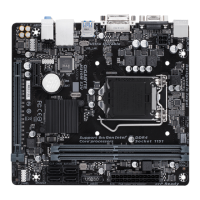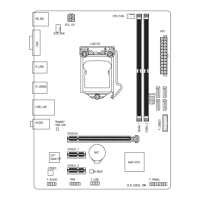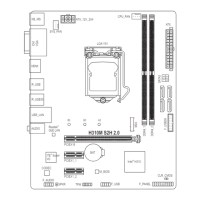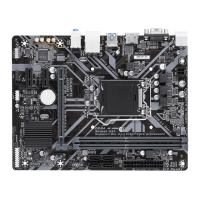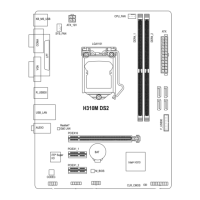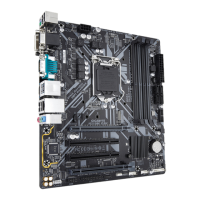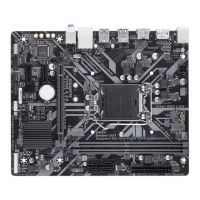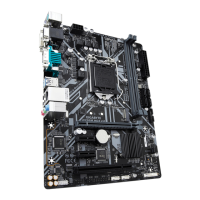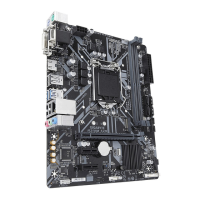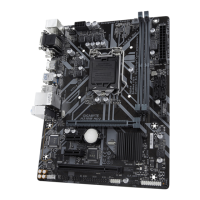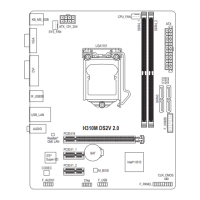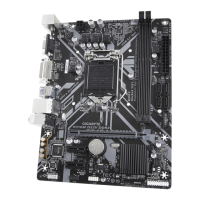Do you have a question about the Gigabyte H310M S2H and is the answer not in the manual?
Lists the items included in the motherboard package.
Essential guidelines and procedures to follow before installing hardware.
Detailed technical specifications of the motherboard components and features.
Step-by-step instructions for installing the Central Processing Unit (CPU).
Instructions on how to install RAM modules into the motherboard slots.
Guide on inserting expansion cards into PCI Express slots.
Description of connectors located on the motherboard's rear panel.
Explanation of internal headers and connectors on the motherboard.
Displays the initial logo screen that appears when the computer boots.
Overview of the main BIOS interface and navigation.
Advanced settings for memory and CPU performance tuning.
Displays motherboard model, BIOS version, and system time settings.
Configuration options related to system boot process and boot order.
Settings for onboard devices like LAN, USB, SATA, and audio.
Settings related to the motherboard's chipset features and integrated graphics.
Options for managing system power states and wake-up events.
Options for saving changes, loading defaults, and exiting the BIOS setup.
Steps to install necessary drivers for the motherboard components.
Information regarding compliance with FCC, CE, RoHS, and WEEE directives.
Details on how to contact GIGABYTE for support and inquiries.
Lists the items included in the motherboard package.
Essential guidelines and procedures to follow before installing hardware.
Detailed technical specifications of the motherboard components and features.
Step-by-step instructions for installing the Central Processing Unit (CPU).
Instructions on how to install RAM modules into the motherboard slots.
Guide on inserting expansion cards into PCI Express slots.
Description of connectors located on the motherboard's rear panel.
Explanation of internal headers and connectors on the motherboard.
Displays the initial logo screen that appears when the computer boots.
Overview of the main BIOS interface and navigation.
Advanced settings for memory and CPU performance tuning.
Displays motherboard model, BIOS version, and system time settings.
Configuration options related to system boot process and boot order.
Settings for onboard devices like LAN, USB, SATA, and audio.
Settings related to the motherboard's chipset features and integrated graphics.
Options for managing system power states and wake-up events.
Options for saving changes, loading defaults, and exiting the BIOS setup.
Steps to install necessary drivers for the motherboard components.
Information regarding compliance with FCC, CE, RoHS, and WEEE directives.
Details on how to contact GIGABYTE for support and inquiries.
| Microphone in | Yes |
|---|---|
| PS/2 ports quantity | 2 |
| USB 2.0 ports quantity | 4 |
| Firewire (IEEE 1394) ports | 0 |
| ECC | No |
| Memory channels | Dual-channel |
| Memory slots type | DIMM |
| Supported memory types | DDR4-SDRAM |
| Maximum internal memory | 32 GB |
| Supported memory clock speeds | 2133, 2400, 2666 MHz |
| Audio chip | Realtek ALC887 |
| Component for | PC |
| Power source type | ATX |
| Motherboard chipset | Intel® H310 |
| Audio output channels | 7.1 channels |
| Motherboard form factor | micro ATX |
| Motherboard chipset family | Intel |
| Windows operating systems supported | Windows 10 |
| Maximum resolution | 4096 x 2160 pixels |
| Processor socket | LGA 1151 (Socket H4) |
| Compatible processor series | Intel Celeron, Intel Core i3, Intel Core i5, Intel Core i7, Intel Pentium |
| Intel® Core i3/i5/i7/i9 series | i3-8xxx, i5-8xxx, i7-8xxx |
| Supported storage drive interfaces | M.2, SATA III |
| BIOS type | UEFI AMI |
| ACPI version | 5.0 |
| BIOS memory size | 16 Mbit |
| System Management BIOS (SMBIOS) version | 2.7 |
| Ethernet interface type | Gigabit Ethernet |
| Harmonized System (HS) code | 84733020 |
| Depth | 185 mm |
|---|---|
| Width | 226 mm |
